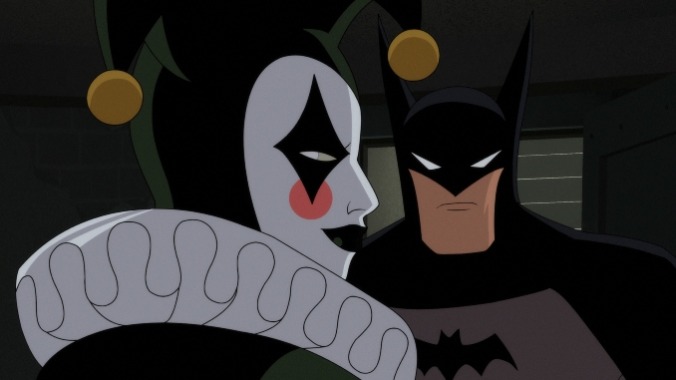Batman: The Caped Crusader Is a Striking Throwback With a Few Fresh Ideas
Photo Courtesy of Prime Video
In Episode 6 of Batman: The Caped Crusader, a new animated take on the iconic vigilante, there’s a moment that works as a capable shorthand for this series: while a pair of security guards discuss the declining socioeconomic conditions in Gotham City and how government policy failures have led to increased poverty and crime, they’re suddenly interrupted by a glowing blue ghost horseman from the 18th century who robs them blind with a flintlock pistol before riding off into the distance while cackling maniacally. Much like the rest of the show, it’s campy and ridiculous, but with a hint of introspection toward this dismal city and the people in it.
In this series, unsurprisingly, we follow Bruce Wayne (Hamish Linklater), aka Batman, as he conducts a one-man war against the criminals of Gotham City. As Wayne, he plays the role of the charming socialite, but when he’s Bats, his true self, he’s stoic, cerebral, and ruthless. His origin story—being orphaned and psychologically scarred by a mugging gone wrong—is the same as usual, but this telling does a particularly good job hinting at the unhealthy extremes of his obsession with cracking criminal skulls. While he’s not quite as openly unhinged as The Batman’s portrayal of the character (although that film’s director, Matt Reeves, serves as executive producer here), this take makes it clear that, despite his intellect and physical prowess, this is a person entirely shackled to the past.
While this rendition of Batman is relatively in line with most recent portrayals, the biggest surface-level difference with this version of the story is that it takes place in the ’40s, making its visual inspirations all the more apparent. Much like Batman: The Animated Series, this show draws on noir-inspired touches: this city exudes quiet menace as light trickles through Venetian blinds and shadows creep dangerously around corners. The gouache texture of the background art calls to mind the painted cells of pre-digital animation, while looming art-deco architecture further places us in this heightened setting. The influence of executive producer Bruce W. Timm, who co-created The Animated Series, is particularly felt in this one’s similarly sharp tone and ominous sense of atmosphere. Although the animation can be a tad stiff and doesn’t entirely live up to the strong backgrounds and shot compositions (especially when it comes to facial expressions), overall, this vision of Gotham looks the part.
And much like Timm’s seminal animated take on this franchise, Caped Crusader also generally does a good job with its bad guys, who predominately come in two flavors: dastardly villain of the week, and more complicated, sympathetic foes. As for the former, the show is frequently structured in an episodic style where Batman goes up against a new opponent in each adventure, using his detective skills to piece together a crime or mystery. As the previously mentioned ghostly highwayman implies, these encounters come with a sense of campy charm that captures the gleeful absurdity of old-school comics.
However, across even its most episodic hijinks, the series also builds up overarching plotlines that tie into its greater villains, many of whom are defined by compelling nuances and motivations that distinguish them from other takes on these characters. Some of them are genuinely trying to make Gotham a better place (while admittedly getting a little bit of self-satisfaction along the way), and fan-favorite Harley Quinn (Jamie Chung) is an excellent example of this—here, her personality is reversed somewhat, and she’s lighthearted as a physiatrist, and cold and intimidating when transformed into her alter ego. In some ways, you could argue her actions have more of a positive result than Batman’s (even if her means are much uglier), making it particularly gripping when they trade blows. Harvey Dent (Diedrich Bader) is interesting in much of the same way, a social-climbing District Attorney who, on some level, seems to genuinely want to make this crooked city a better place by running for office against the current self-important mayor (even if he’s very smarmy about it), but finds himself tempted into dubious alliances to win the election.
-

-

-

-

-

-

-

-

-

-

-

-

-

-

-

-

-

-

-

-

-

-

-

-

-

-

-

-

-

-

-

-

-

-

-

-

-

-

-

-








































